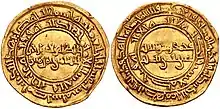Al-Zahir li-i'zaz Din Allah
Abū'l-Ḥasan ʿAlī ibn al-Ḥākim (Arabic: أبو الحسن علي ابن الحاكم; 20 June 1005 – 13 June 1036), better known with his regnal name al-Zāhir li-iʿzāz Dīn Allāh (Arabic: الظاهر لإعزاز دين الله, lit. 'He Who Appears Openly to Strengthen the Religion of God'[1]), was the seventh caliph of the Fatimid dynasty (1021–1036). Al-Zahir assumed the caliphate after the disappearance of his father al-Hakim bi-Amr Allah. According to the Hijri Calendar, his birth date is 3rd of Ramzaan 395 A.H.[2][3]
| Ali al-Zahir | |
|---|---|
 Gold dinar of al-Zahir | |
| Caliph of the Fatimid Dynasty | |
| Reign | 1021–1035 |
| Predecessor | Al-Hakim bi-Amr Allah |
| Successor | Al-Mustansir Billah |
| Born | 20 June 1005 |
| Died | 13 June 1036 |
| Spouse | Rasad, amongst others |
| Dynasty | Fatimid |
| Religion | Isma'ili Shia Islam |
| Part of a series on Shīa Islam
Isma'ilism |
|---|
 |
|
|
Reign
At the time of al-Hakim's disappearance on 14 February 1021, his sister, Sitt al-Mulk, took the reins of power. She disregarded the previous appointment of a cousin, Abu'l-Qasim Abd al-Rahim, as heir apparent by al-Hakim, and instead raised al-Hakim's 16-year-old son Ali to the throne. Ali received the public oath of allegiance on 28 March, with the regnal name al-Zāhir li-iʿzāz Dīn Allāh.[4] His rival, Abu'l-Qasim, was recalled from Damascus, where he was serving as governor, to Cairo, where he died—reportedly by suicide—a few months later.[4]
Until her death in February 1023, the government was conducted by Sitt al-Mulk, who according to historian Thierry Bianquis proved "a true stateswoman".[4] Al-Zahir himself never displayed much interest in wielding power, instead spending his days in idle pleasure drinking wine and enjoying the black slaves of his harem.[4] He was the first Fatimid monarch to actively shift the responsibility of governing onto his officials, inaugurating a trend that would eventually lead to the complete political impotence of the Fatimid caliphs.[4]
Under this regime, the Fātimid state slipped into crisis - in Egypt, famine and plague led to anarchy in the years 1023-1025, and in Palestine and Syria, there was a revolt amongst the Bedouin (1024–1029). The coalition of rebels was fragmented by Fātimid diplomacy, after which General Anushtakin al-Dizbari was able to defeat it militarily.
Meanwhile, in 1028 one of the governing circle, ʻAlī ibn Ahmad Jarjarai, was able to eliminate his colleagues and take over the office of vizir, which he managed to retain until 1045. He enjoyed good relations with the Byzantine Empire, even though the suzerainty over Aleppo was constantly disputed, occasionally coming to arms. To improve relations with Byzantium and the Christian subjects of the realm, the rebuilding of the Church of the Holy Sepulchre, destroyed in 1009, was authorised under his caliphate in a treaty with the Byzantine Emperor Romanus III. Actual building work, funded by the Byzantines, was not undertaken until 1042.
Persecution of Druze
For the next seven years, the Druze faced extreme persecution by the new caliph, al-Zahir, who wanted to eradicate the faith.[5] This was the result of a power struggle inside of the Fatimid empire in which the Druze were viewed with suspicion because of their refusal to recognize the new caliph as their Imam. Many spies, mainly the followers of al-Darazi, joined the Unitarian movement in order to infiltrate the Druze community. The spies set about agitating trouble and soiling the reputation of the Druze. This resulted in friction with the new caliph who clashed militarily with the Druze community. The clashes ranged from Antioch to Alexandria, where tens of thousands of Druze were slaughtered by the Fatimid army,[6] "this mass persecution known by the Druze as the period of the mihna".[7] The largest massacre was at Antioch, where 5,000 prominent Druze were killed, followed by that of Aleppo.[6] As a result, the faith went underground, in hope of survival, as those captured were either forced to renounce their faith or be killed. Druze survivors "were found principally in southern Lebanon and Syria". In 1038, two years after the death of al-Zahir, the Druze movement was able to resume because the new leadership that replaced him had friendly political ties with at least one prominent Druze leader.[5]
Death and succession
The period of his Imamate was sixteen years. After ʻAlī died of the plague 13 June 1036, his son became the eighth caliph under the throne name of al-Mustansir.
See also
- Family tree of Muhammad#Family tree linking prophets to Imams
- List of Ismaili imams
- List of rulers of Egypt
References
- Brett 2017, p. 157.
- "AZ-ZAHIR (411-427/1021-1036)". ismaili.net. Retrieved 26 October 2017.
- "Historical research". druzehistoryandculture.com. Retrieved 26 October 2017.
- Bianquis 2002, p. 391.
- Rebecca Erickson. "The Druze" (PDF). Encyclopedia of New Religious Movements. Archived from the original (PDF) on 18 May 2015.
- Moukarim, Moustafa F, About the Faith of The Mo'wa'he'doon Druze, archived from the original on 26 April 2012
- Parsons, L. (2000). The Druze between Palestine and Israel 1947–49. Springer. p. 2. ISBN 9780230595989.
With the succession of al-Zahir to the Fatimid caliphate a mass persecution (known by the Druze as the period of the mihna) of the Muwaḥḥidūn was instigated ...
Sources
- Bianquis, Thierry (2002). "al-Ẓāhir li-Iʿzāz Dīn Allāh". In Bearman, P. J.; Bianquis, Th.; Bosworth, C. E.; van Donzel, E. & Heinrichs, W. P. (eds.). The Encyclopaedia of Islam, New Edition, Volume XI: W–Z. Leiden: E. J. Brill. pp. 391–392. ISBN 978-90-04-12756-2.
- Brett, Michael (2017). The Fatimid Empire. The Edinburgh History of the Islamic Empires. Edinburgh: Edinburgh University Press. ISBN 978-0-7486-4076-8.
- Canard, Marius (1965). "D̲j̲arrāḥids". In Lewis, B.; Pellat, Ch. & Schacht, J. (eds.). The Encyclopaedia of Islam, New Edition, Volume II: C–G. Leiden: E. J. Brill. pp. 482–485. OCLC 495469475.
- Cappel, Andrew J. (1994). "The Byzantine Response to the ʿArab (10th–11th Centuries)". Byzantinische Forschungen. A. Hakkert. 20: 113–132.
- Gil, Moshe (1997) [1983]. A History of Palestine, 634–1099. Translated by Ethel Broido. Cambridge: Cambridge University Press. ISBN 0-521-59984-9.
- Halm, Heinz (2003). Die Kalifen von Kairo: Die Fāṭimiden in Ägypten, 973–1074 [The Caliphs of Cairo: The Fatimids in Egypt, 973–1074] (in German). Munich: C. H. Beck. ISBN 3-406-48654-1.
- Kennedy, Hugh (2004). The Prophet and the Age of the Caliphates: The Islamic Near East from the 6th to the 11th Century (Second ed.). Harlow: Longman. ISBN 978-0-582-40525-7.
- Lev, Yaacov (2003). "Turks in the Political and Military Life of Eleventh-Century Egypt and Syria". In Hidemitsu, Kuroki (ed.). The Influence of Human Mobility in Muslim Societies. Kegan Paul. pp. 43–62. ISBN 0710308027.
Al-Zahir li-i'zaz Din Allah Born: June 20, 1005 Died: June 13, 1036 | ||
| Regnal titles | ||
|---|---|---|
| Preceded by al-Hakim bi-Amr Allah |
Fatimid Caliph 1021–1036 |
Succeeded by al-Mustansir Billah |
| Shia Islam titles | ||
| Preceded by al-Hakim bi-Amr Allah |
Imam of Isma'ilism 1021–1036 |
Succeeded by al-Mustansir Billah |